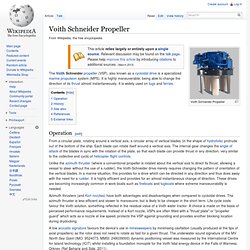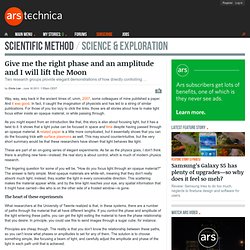

Voith Schneider Propeller. Voith Schneider Propeller The Voith Schneider propeller (VSP), also known as a cycloidal drive is a specialized marine propulsion system (MPS).

It is highly maneuverable, being able to change the direction of its thrust almost instantaneously. It is widely used on tugs and ferries. Operation[edit] From a circular plate, rotating around a vertical axis, a circular array of vertical blades (in the shape of hydrofoils) protrude out of the bottom of the ship. Unlike the azimuth thruster (where a conventional propeller is rotated about the vertical axis to direct its thrust, allowing a vessel to steer without the use of a rudder), the Voith-Schneider drive merely requires changing the pattern of orientation of the vertical blades. Azimuth thrusters (and Kort nozzles) have both advantages and disadvantages when compared to cycloidal drives. VSPs are offered with an input power range of 160 kW to 3900 kW[1] History[edit] Twin Voith Schneider propeller with thrust plate on a tug's hull.
D-Dalus - an entirely new genre of aircraft arrives. Austrian research company IAT21 has presented a new type of aircraft at the Paris Air Show which has the potential to become aviation's first disruptive technology since the jet engine.

View all The D-Dalus (a play on Daedalus from Greek mythology) is neither fixed wing or rotor craft and uses four, mechanically-linked, contra-rotating cylindrical turbines, each running at the same 2200 rpm, for its propulsion. The key to the D-Dalus' extreme maneuverability is the facility to alter the angle of the blades (using servos) to vector the forces, meaning that the thrust can be delivered in your choice of 360 degrees around any of the three axes.
Hence D-Dalus can launch vertically, hover perfectly still and move in any direction, and that's just the start of the story. Like most cars and aircraft these days, it sounds very complex but it's all controlled by computer algorithms, so it's simple joystick control for the user, and far less exacting than a helicopter to fly. Clean, cheap hydrogen production from water using cobalt catalyst. For years, proponents of the hydrogen economy have argued that hydrogen will replace traditional hydrocarbon fuels for transportation purposes.

But, so far, a lack of new, inexpensive methods for hydrogen production and storage has impeded this goal. Over the last several years, an MIT professor has been pushing cobalt catalysts as a cheap replacement for the expensive metals typically used to split water. A paper in this week's Proceedings of the National Academies of Science describes the latest progress here: integrating the cobalt catalyst with a silicon solar cell to create a device that uses the sun to split water.
Hydrogen is a desirable fuel, because when it is burned or otherwise consumed (as in a fuel cell), it only produces water, although combustion results in small amounts of nitrogen oxides as by-products. Give me the right phase and an amplitude and I will lift the Moon. Way, way, way back in the ancient times of, umm, 2007, some colleagues of mine published a paper.

And it was good. In fact, it caught the imagination of physicists and has led to a string of similar publications. For those of you too lazy to click the links, those are all stories about how to make light focus either inside an opaque material, or while passing through. As you might expect from an introduction like that, this story is also about focusing light, but it has a twist to it. It shows that a light pulse can be focused in space and time despite having passed through an opaque material. These are part of an on-going series of elegant experiments. The lingering question for some of you will be, "How do you focus light through an opaque material?
" The heart of these experiments What researchers at the University of Twente realized is that, in these systems, there are a number of paths through the material that all have different lengths. Principles are cheap though. Is gravity not actually a force? Forcing theory to meet experiments. How are controversial ideas handled by modern science?

A common charge leveled against science (generally by those who are unhappy with its conclusions) is that the only way to get funding or continue your research is by going along with the current theories and not rocking the boat. For those who spend their careers in science, this is laughable—it is those who successfully rock the boat who are the most successful. In this article, we are going to look at a manuscript that purports to overturn hundreds of years of accepted ideas about gravity, and use it as an illustration of how controversial ideas are dealt with in modern physics. It was Isaac Newton who first proposed a universal law of gravitation, where every massive body in the universe was attracted to every other one.
This simple law proved extremely powerful, able to explain the orbits of planets and the reason the apocryphal apple fell on his head. Some background reading A mind-bending proposal Dr. Not so fast Dr.